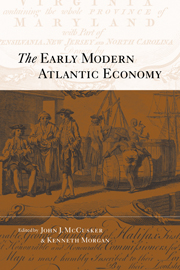Book contents
- Frontmatter
- Contents
- List of figures
- List of tables
- List of abbreviations
- List of contributors
- Dedication
- Introduction
- Part I The role of merchants and their connections
- Part II The development of trades
- 3 Property versus commerce in the mid-eighteenth-century port of London
- 4 Irish businessman and French courtier: the career of Thomas sutton, comte de Clonard, c. 1722–1782
- 5 ‘A revolution in the trade’: wine distribution and the development of the infrastructure of the Atlantic market economy, 1703–1807
- 6 Law, credit, the supply of labour, and the organization of sugar production in the colonial Greater Caribbean: a comparison of Brazil and Barbados in the seventeenth century
- 7 The revolutionary impact of European demand for tropical goods
- 8 The business of distilling in the Old World and the New World during the seventeenth and eighteenth centuries: the rise of a new enterprise and its connection with colonial America
- Part III Imperial economies
- Part IV Colonial working societies
- Index
6 - Law, credit, the supply of labour, and the organization of sugar production in the colonial Greater Caribbean: a comparison of Brazil and Barbados in the seventeenth century
from Part II - The development of trades
Published online by Cambridge University Press: 16 October 2009
- Frontmatter
- Contents
- List of figures
- List of tables
- List of abbreviations
- List of contributors
- Dedication
- Introduction
- Part I The role of merchants and their connections
- Part II The development of trades
- 3 Property versus commerce in the mid-eighteenth-century port of London
- 4 Irish businessman and French courtier: the career of Thomas sutton, comte de Clonard, c. 1722–1782
- 5 ‘A revolution in the trade’: wine distribution and the development of the infrastructure of the Atlantic market economy, 1703–1807
- 6 Law, credit, the supply of labour, and the organization of sugar production in the colonial Greater Caribbean: a comparison of Brazil and Barbados in the seventeenth century
- 7 The revolutionary impact of European demand for tropical goods
- 8 The business of distilling in the Old World and the New World during the seventeenth and eighteenth centuries: the rise of a new enterprise and its connection with colonial America
- Part III Imperial economies
- Part IV Colonial working societies
- Index
Summary
One of the many minor mysteries surrounding the history of sugar production in the colonial greater Caribbean concerns differences in the organization of production between the English islands and Brazil.1 In Brazil, production was dispersed, as much of the cane was grown by small farmers (lavradores de cana), some of them tenants, some independent landowners who took their crop to their landlord's mill or to some other big planter's mill for processing. On the islands, by contrast, production was centralized, as most of the cane was tended by slaves owned by a big planter and processed at the planter's own mill. Given the high productivity of gang labour, there would seem to be substantial advantages to the centralized system that prevailed on the islands. It is therefore something of a puzzle why the centralized system did not prevail throughout the region. This chapter, through a focus on Barbados and Brazil in the seventeenth century, attempts a solution to that puzzle. While it might at first seem odd to compare a small island like Barbados to a colony as large as Brazil, several considerations suggest that the comparison is in fact well grounded. In the middle seventeenth century, the period focused on here, Barbados was Brazil's most serious competitor as a sugar producer.
- Type
- Chapter
- Information
- The Early Modern Atlantic Economy , pp. 154 - 162Publisher: Cambridge University PressPrint publication year: 2001
- 1
- Cited by



